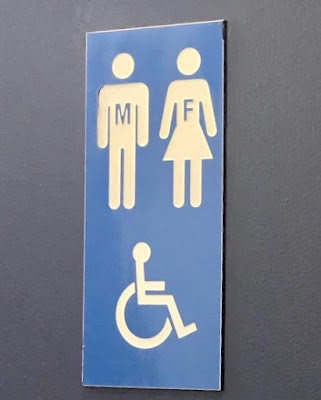 |
| Gendered public washrooms are not the only option |
Gender-neutral washrooms are popping up all over metropolitan areas, including universities, government buildings, community centers, and trendy cafes. Many of these washrooms existed long before they were labeled “gender-neutral.” They were simply single-use washroom facilities in places that didn’t have room for more than one washroom.
There has been a lot of concern over the last few years regarding gender-neutral washrooms. Are they more dangerous? Are they putting women and children at risk of potential predators? What does the research say and how we can move forward in making safe spaces for everyone?
 |
| Single-use washrooms have been around for a long time |
We’ve written in this blog before about how bathrooms are a basic human right. However, for many non-binary and trans people, proposed anti-trans laws in the United States make a simple, human action a political and personal minefield.
WHAT THE RESEARCH SHOWS
The research doesn’t support the concerns around safety issues. Gender-neutral washrooms (or even washrooms that allow you to choose based on your self-identified gender) do not make bathrooms unsafe for women or children. Incidents are rare in the first place and have been found to be completely unrelated to legal decisions.
Second, gender-neutral washrooms improve safety for those who identify as trans or non-binary. These individuals suffer much higher rates of intimidation and harassment than the general population and, therefore, creating safe washrooms can improve safety for the trans population while not increasing risks for others.
Third, gender-neutral washrooms benefit more than the non-binary and trans community. These washrooms improve accessibility issues and reduce wait times for women since women spend slightly more time in the bathroom than men.
 |
| Everyone needs to pee in safety |
Women who attend large events, like a concert or the theatre, are acutely aware of the long lines for women’s washrooms. In fact, some sporting facilities have increased the number of washrooms for men, creating further disparities in access to washrooms for women.
Some might laugh off the problem of women’s washroom lines, but if you are dealing with an invisible disability or you are pregnant, the lack of easily accessible washrooms can lead to some major issues.
The fact is, from all the available research, concerns about safety and gender-neutral washrooms are not based on the empirical evidence. Instead, they appear based on the politics of exclusion! And even with all the available evidence, decisions about safety should not only be based only on research; they should also protect those who are the most marginalized and at-risk in our communities.
Sometimes that means just changing the sign on the door.
Leave a comment
Please add comments to SafeGrowth. I will post everyone except posts with abusive, off-topic, or offensive language; any discriminatory, racist, sexist or homophopic slurs; thread spamming; or ad hominem attacks.
If your comment does not appear in a day due to blogspot problems send it to safegrowth.office@gmail.com and we'll post direct.